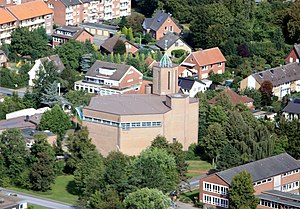St. Paulus (Harsewinkel)
|
Aerial view of the church |
|
| Basic data | |
| Denomination | Roman Catholic |
| place | Harsewinkel , Germany |
| diocese | Diocese of Münster |
| Patronage | Paul |
| Building history | |
| architect | Hans Schilling |
| construction time | May 31, 1966 - 1967 |
| Building description | |
| inauguration | September 9, 1967 |
| Function and title | |
| 51 ° 57 '52 " N , 8 ° 12' 44.9" E | |
St. Paulus is the youngest Catholic branch church of the parish of St. Lucia in the East Westphalian town of Harsewinkel in North Rhine-Westphalia , Germany .
history
In the 1950s and 1960s, the number of Catholics in Harsewinkel rose to over 9,000. The parish of St. Lucia became confusing and pastoral care close to the people was hardly possible. At the beginning of the 1960s there were first considerations to found a new parish with its own church. Chaplain Karl-Gerd Haggeney was then transferred to Harsewinkel to fulfill this assignment. After the planning of the parish began, the parish area was defined as the so-called Rövekamp, the Überems peasantry and the western part of the Rheda peasantry.
The committees of the St. Lucia parish as well as active persons of the new parish stood by the chaplain. In May 1964, the Episcopal Vicariate General granted permission to hold school services in the break hall of the Overberg School. After the completion of the Harsewinkler Realschule, Holy Mass was also celebrated on Sundays in the atrium there .
In the further development of the parish, all responsible bodies decided to dedicate the parish and the church to the Apostle of the Nations Paul . The plan by the Cologne architect Hans Schilling was selected from the submitted church building designs . The construction costs were around 1.5 million DM. 250,000 DM came from the diocese of Münster , a parish plot of land was sold for 390,000 DM, the city of Harsewinkel supported the project with 250,000 DM and 600,000 DM could be contributed by donations from the population.
On October 14, 1965, the church council of St. Lucia under Dechant Markforth approved the construction of the new church. On December 18 of that year the Episcopal General Vicariate followed the decision. The building permit was granted on February 28, 1966 and the work was awarded to the Büscher & Sohn company in Münster on April 18, 1966 . On 31 May 1966, the construction of began, so on July 24, 1966 foundation by the provost Clemens Echelmeyer was laid from Münster.
The church construction made great progress, so that the topping-out ceremony could be celebrated on October 6, 1966 . Almost a year later, on September 9, 1967, Auxiliary Bishop Heinrich Tenhumberg consecrated the church and handed it over to the congregation. The parish became an independent pastoral rectorate under the leadership of the parish rector Haggeney. On February 15, 1968 the elevation to the parish took place, on March 17, Karl-Gerd Haggeney was appointed pastor in St. Paulus.
The first election to the church council took place on March 24, 1968 and the first election to the parish committee on May 5, 1968.
On August 11, 1985 the crowning of the church tower was put on.
For Apr. 27, 2014 lifted Bishop Felix Genn the independent parish of St. Paul and built a new parish of St. Lucia. The former parish church became a branch church.
Furnishing
organ
The first organ was inaugurated on September 17, 1977, but was replaced by a new organ in 2004. The French-Romantic instrument was built by the organ building company Manufacture d'Orgues Muhleisen (Strasbourg) and has 35 sounding registers and a carillon on three manuals and pedal, plus transmissions from the Récit to the Positif and from the Grand Orgue to the pedal, see above that the instrument has a total of 45 registers. The key actions are mechanical, the stop actions are electrical.
|
|
|
|
|||||||||||||||||||||||||||||||||||||||||||||||||||||||||||||||||||||||||||||||||||||||||||||||||||||||||||||||||||||||||||||||||||||||||||||||||||||||||||||||||||||||||||||||||||||||||||||||||||||||||||||
- Pair : II / I, III / I, III / II
- Game Aids : 18000 times combination system
Hansjörg Albrecht made several CD recordings on the organ.
Bells
| No. | Surname | Casting year | Diameter (mm) |
Mass (kg) |
Percussive ( HT - 1 / 16 ) |
Artist | inscription |
|---|---|---|---|---|---|---|---|
| 1 | 1969 | 92 cm | a ′ | Eifeler bell foundry , Brockscheid | |||
| 2 | 1969 | 82 cm | H' | Eifeler bell foundry, Brockscheid | |||
| 3 | 1969 | 68 cm | d ″ | Eifeler bell foundry, Brockscheid |
Source:
Pastor
- 1968−1981: Karl-Gerd Haggeney
- 1981−1990: Hans Hasken
- 1990-1995: Günther Lube
- 1995-2001: Raimund Uhling
- 2001–2003: Josef Heisterkamp
- 2003-2017: Wim Wigger
Individual evidence
- ↑ Further information on the new building and the disposition of the organ of St. Paulus
- ^ Bishop's General Vicariate Münster (ed.): The Diocese of Münster . tape 3 . Verlag Regensberg, Münster 1993, ISBN 3-7923-0646-8 , p. 437 f .

